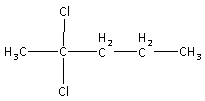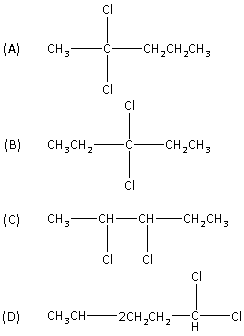
Answer
451.5k+ views
Hint: Fehling test is a characteristic test used to detect aldehydes. Thus, compounds other than aldehydes do not give Fehling test. The intermediate formed in the reaction does not give Fehling test and thus, it is not an aldehyde. Thus, the product formed in the reaction is a ketone. The intermediate reaction with ${\text{N}}{{\text{H}}_{\text{2}}}{\text{OH}}$ gives iodoform. Formation of iodoform is a characteristic test of methyl ketone $\left( {{\text{C}}{{\text{H}}_{\text{3}}} - {\text{C}} = {\text{O}}} \right)$ group. Thus, the intermediate form is a ketone with methyl $\left( { - {\text{C}}{{\text{H}}_3}} \right)$ group attached to it.
Complete step by step answer:
-A compound (A) has a molecular formula ${{\text{C}}_{\text{5}}}{{\text{H}}_{{\text{10}}}}{\text{C}}{{\text{l}}_{\text{2}}}$. This compound undergoes hydrolysis. Hydrolysis means that it reacts with ${{\text{H}}_{\text{3}}}{{\text{O}}^{\text{ + }}}$ and forms a compound with molecular formula ${{\text{C}}_{\text{5}}}{{\text{H}}_{{\text{10}}}}{\text{O}}$ which reacts with ${\text{N}}{{\text{H}}_{\text{2}}}{\text{OH}}$ to give iodoform. The reaction is as follows:

The compound with molecular formula ${{\text{C}}_{\text{5}}}{{\text{H}}_{{\text{10}}}}{\text{O}}$ can be an aldehyde or a ketone. But it does not give the Fehling test. Fehling test is a characteristic test for aldehydes. Thus, the compound with molecular formula ${{\text{C}}_{\text{5}}}{{\text{H}}_{{\text{10}}}}{\text{O}}$ is not an aldehyde. Thus, it is a ketone.
Also, ${{\text{C}}_{\text{5}}}{{\text{H}}_{{\text{10}}}}{\text{O}}$ produces iodoform which is a characteristic of methyl ketone group. Thus, ${{\text{C}}_{\text{5}}}{{\text{H}}_{{\text{10}}}}{\text{O}}$ is a ketone with methyl group attached to it. Thus, the structure is,

${{\text{C}}_{\text{5}}}{{\text{H}}_{{\text{10}}}}{\text{O}}$ is produced by the hydrolysis of ${{\text{C}}_{\text{5}}}{{\text{H}}_{{\text{10}}}}{\text{C}}{{\text{l}}_{\text{2}}}$. Thus, in ${{\text{C}}_{\text{5}}}{{\text{H}}_{{\text{10}}}}{\text{O}}$, the $ = {\text{O}}$ atom is replaced by two $ - {\text{Cl}}$ atoms. Thus, the structure of compound A $\left( {{{\text{C}}_{\text{5}}}{{\text{H}}_{{\text{10}}}}{\text{C}}{{\text{l}}_{\text{2}}}} \right)$ is,

So, the correct answer is “Option A”.
Note: The compound gives Fehling test negative. Thus, it cannot be an aldehyde but can be a ketone. The compound on reaction with ${\text{N}}{{\text{H}}_{\text{2}}}{\text{OH}}$ gives iodoform. Iodoform is a characteristic test for methyl ketone groups. Thus, compound is a ketone containing methyl group.
Complete step by step answer:
-A compound (A) has a molecular formula ${{\text{C}}_{\text{5}}}{{\text{H}}_{{\text{10}}}}{\text{C}}{{\text{l}}_{\text{2}}}$. This compound undergoes hydrolysis. Hydrolysis means that it reacts with ${{\text{H}}_{\text{3}}}{{\text{O}}^{\text{ + }}}$ and forms a compound with molecular formula ${{\text{C}}_{\text{5}}}{{\text{H}}_{{\text{10}}}}{\text{O}}$ which reacts with ${\text{N}}{{\text{H}}_{\text{2}}}{\text{OH}}$ to give iodoform. The reaction is as follows:

The compound with molecular formula ${{\text{C}}_{\text{5}}}{{\text{H}}_{{\text{10}}}}{\text{O}}$ can be an aldehyde or a ketone. But it does not give the Fehling test. Fehling test is a characteristic test for aldehydes. Thus, the compound with molecular formula ${{\text{C}}_{\text{5}}}{{\text{H}}_{{\text{10}}}}{\text{O}}$ is not an aldehyde. Thus, it is a ketone.
Also, ${{\text{C}}_{\text{5}}}{{\text{H}}_{{\text{10}}}}{\text{O}}$ produces iodoform which is a characteristic of methyl ketone group. Thus, ${{\text{C}}_{\text{5}}}{{\text{H}}_{{\text{10}}}}{\text{O}}$ is a ketone with methyl group attached to it. Thus, the structure is,

${{\text{C}}_{\text{5}}}{{\text{H}}_{{\text{10}}}}{\text{O}}$ is produced by the hydrolysis of ${{\text{C}}_{\text{5}}}{{\text{H}}_{{\text{10}}}}{\text{C}}{{\text{l}}_{\text{2}}}$. Thus, in ${{\text{C}}_{\text{5}}}{{\text{H}}_{{\text{10}}}}{\text{O}}$, the $ = {\text{O}}$ atom is replaced by two $ - {\text{Cl}}$ atoms. Thus, the structure of compound A $\left( {{{\text{C}}_{\text{5}}}{{\text{H}}_{{\text{10}}}}{\text{C}}{{\text{l}}_{\text{2}}}} \right)$ is,

So, the correct answer is “Option A”.
Note: The compound gives Fehling test negative. Thus, it cannot be an aldehyde but can be a ketone. The compound on reaction with ${\text{N}}{{\text{H}}_{\text{2}}}{\text{OH}}$ gives iodoform. Iodoform is a characteristic test for methyl ketone groups. Thus, compound is a ketone containing methyl group.
Recently Updated Pages
Who among the following was the religious guru of class 7 social science CBSE

what is the correct chronological order of the following class 10 social science CBSE

Which of the following was not the actual cause for class 10 social science CBSE

Which of the following statements is not correct A class 10 social science CBSE

Which of the following leaders was not present in the class 10 social science CBSE

Garampani Sanctuary is located at A Diphu Assam B Gangtok class 10 social science CBSE

Trending doubts
Which are the Top 10 Largest Countries of the World?

Fill the blanks with the suitable prepositions 1 The class 9 english CBSE

How do you graph the function fx 4x class 9 maths CBSE

Find the value of the expression given below sin 30circ class 11 maths CBSE

In what year Guru Nanak Dev ji was born A15 April 1469 class 11 social science CBSE

The Equation xxx + 2 is Satisfied when x is Equal to Class 10 Maths

Why is there a time difference of about 5 hours between class 10 social science CBSE

Difference between Prokaryotic cell and Eukaryotic class 11 biology CBSE

What is BLO What is the full form of BLO class 8 social science CBSE





